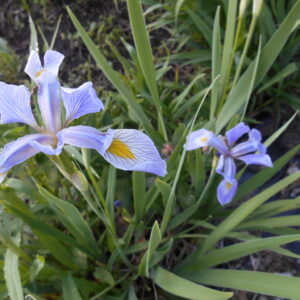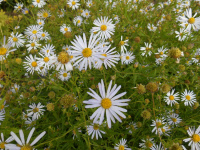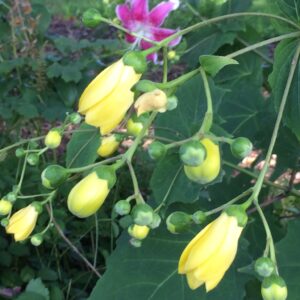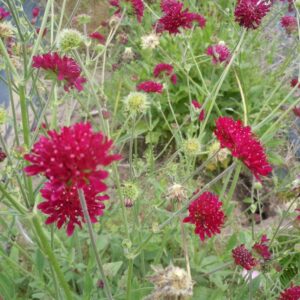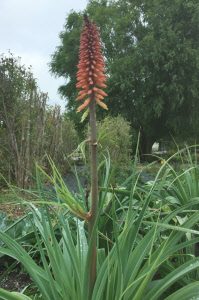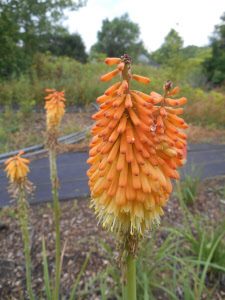Shop
Showing 441–448 of 785 results
-
Iris versicolor Blue flag Z 3-9
Purple, lavender or blue flowers in June
Purple, lavender or blue flowers in June
Size: 36" x 12"
Care: sun, moist to moist well-drained soil
Native: Eastern United States, Wisconsin nativeIris is named after the Greek goddess who accompanied the souls of women to the Elysian Fields by way of the rainbow. Her footprints left flowers the colors of the rainbow. Iris means the eye of heaven. Omaha Indians used the roots topically to cure earaches. Other tribes applied a poultice to cure sores and bruises. Root is poisonous. Cultivated in gardens since the 1700’s.
-
Jasione montana syn J. laevis Sheep’s bit Scabious BIENNIAL Z 5-8
Globes of small blue flowers in July-August
ARCHIVED
Note: This is a plant not currently for sale. This is an archive page preserved for informational use.
Globes of small blue flowers in July-August
Size: 12” x 8”
Care: full sun in well-drained soil.
Native: Europe and Russia
Wildlife Value: attracts bees, butterflies and many other pollinators.Described by Linnaeus 1753
-
Kalimeris incisa syn. Asteromoea , Kalimeris integrifolia False aster Z 4-8
Pale lavender single daisies that bloom from July – September, deadhead after 1st flush of blooms for repeat flowering
Pale lavender single daisies that bloom from July – September, deadhead after 1st flush of blooms for repeat flowering
Size: 2-3’ x 12”
Care: sun to part shade in moist well-drained to dry soil. Cut back halfway in early June to make bushier with more flowers.
Native: Japan, northern China & SiberiaCollected before 1812 when first named and described. Renamed about five times July 6, 1872 issue of The Garden reported that “Callimeris incise” was blooming in London.
-
Kirengeshoma palmata Yellow Waxbells 5-8
Moon yellow bells – gracefully droop in late summer and fall. One of internationally known garden designer Piet Oudolf’s 100 “MUST HAVE” plants, Gardens Illustrated 94 (2013)
Moon yellow bells – gracefully droop in late summer and fall. One of internationally known garden designer Piet Oudolf’s 100 “MUST HAVE” plants, Gardens Illustrated 94 (2013)
Size: 36" x 30"
Care: part shade to shade in moist to moist well-drained soil
Native: Mt. Ishizuchi in Japan
Wildlife Value: pollinated by bumblebees. deer and rabbit resistant
Awards: Royal Horticultural Society Award of Garden Merit.Kirengeshoma means “yellow” in Japanese. 1st described in Tokyo’s Botanical Society Botanical Magazine in 1890.
-
Knautia macedonica syn. Scabiosa rumelica Pincushion plant Z 5-9
Claret pincushions float at the tips of airy wands all summer & fall
Claret pincushions float at the tips of airy wands all summer & fall
Size: 2- 3’ x 10”
Care: sun in well-drained soil. Keep compact by cutting back to 10” in spring, if you wish
Native: Central Europe
Wildlife Value: attracts butterflies and beesKnautia named for German doctor & botanist Christoph Knaut (1656-1716) who published a method of classifying plants. Collected before 1879
-
Kniphofia caulescens Red hot poker, Regal torch lily Z 5-10
fat spikes of flowers open coral-red, turning pale lemon-yellow
Evergreen perennial with short, stout stems bearing grass-like broad, grey-green leaves. Blooming July to August, fat spikes of flowers open coral-red, turning pale lemon-yellow
Size: 3’ x 2-3’
Care: sun in moist well-drained soil
Native: Lesotho South Africa
Wildlife Value: deer and rabbit resistant. Attracts hummingbirds
Awards: Royal Horticultural Society Award of Garden Merit; Denver Botanic Garden Plant SelectIntroduced to gardens by Mr. T. Cooper about 1860. 1st described by French botanist Carrière in Revue Horticole in 1884
-
Kniphofia triangularis Dwarf Red hot poker Z 5-8
From early to late summer, with dead-heading, vivid coral spikes, like a torch .
From early to late summer, with dead-heading, vivid coral spikes, like a torch. This plant has everything- resistant to deer & rabbits, long blooming, great cut flowers, hummingbirds and butterflies love it.
Size: 2’ x 12-18”
Care: sun in moist to well-drained soil, Drought tolerant once established
Native: mountain grassland & moist areas in the Eastern Cape to the Northern province of South Africa.
Wildlife Value: resistant to deer & rabbits, hummingbirds and butterflies love it.1st described in 1854 in Enumeratio Plantarum Omnium Hucusque Cognitarum, Vol. 4 p. 551
-
Kniphofia uvaria Red hot poker, Torch lily Z 5-10
Vibrant red and yellow spikes of tube-shaped flowers
ARCHIVED
Note: This is a plant not currently for sale. This is an archive page preserved for informational use.
Vibrant red and yellow spikes of tube-shaped flowers in early summer arise on leafless stems (called a scape) from a basal clump of strap-like leaves
Size: 2-3’ x 12-15”
Care: sun in moist well-drained to well-drained soil
Native: South Africa
Wildlife Value: deer & rabbit resistant, attracts hummingbirdsIntroduced to English gardens c. 1700 and called Alöe uvaria then renamed by English botanist Wm. Jackson Hooker. The Gardeners Dictionary (1783): “The flowers are produced in close thick spikes, upon stalks near three feet high, They are of an Orange colour…” Illustrated in Curtis’ Botanical Garden 80 (1 Nov 1854).

